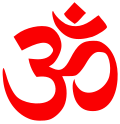Content
The Principal Upanishads, which were composed probably between 600 and 300 BCE, constitute the concluding portion of the Veda. [2] According to most Hindu traditions, ten Upanishads are considered as Principal Upanishads, but some scholars include Śvetāśvatara, Kauṣītaki and Maitrāyaṇīya into the list. [3] [4] [5] The founders of the major schools of Vedanta, viz., Adi Shankara and Madhvacharya wrote bhāṣyas (commentaries) on these ten Principal Upanishads. Even though Ramanuja did not write individual commentaries on Principal Upanishads, he quoted many hundreds of quotations from Upanishads in his Sri Bhasya. In the Ramanuja lineage, one of his followers, Rangaramanuja, wrote commentaries on almost all of the Principal Upanishads around the 1600s. [6] [7]
The ten Principal Upanishads are:
- Īśā (IsUp), Yajurveda
- Kena (KeUp), Samaveda
- Kaṭha (KaUp), Yajurveda
- Praśna (PrUp), Atharvaveda
- Muṇḍaka (MuUp), Atharvaveda
- Māṇḍūkya (MaUp), Atharvaveda
- Taittirīya (TaiUp), Yajurveda
- Aitareya, (AiUp), Rigveda
- Chāndogya (ChhUp), Samaveda
- Bṛhadāraṇyaka (BṛUp), Yajurveda
The Principal Upanishads are accepted as śruti by all Hindus, or the most important scriptures of Hinduism. [8] The Principal Upanishads are separated into three categories: prose (Taittirīya, Aitareya, Chāndogya, Bṛhadāraṇyaka), verse (Īśā, Kaṭha, Muṇḍaka), and prose (classical Sanskrit) (Māṇḍūkya). [2]
This page is based on this
Wikipedia article Text is available under the
CC BY-SA 4.0 license; additional terms may apply.
Images, videos and audio are available under their respective licenses.

